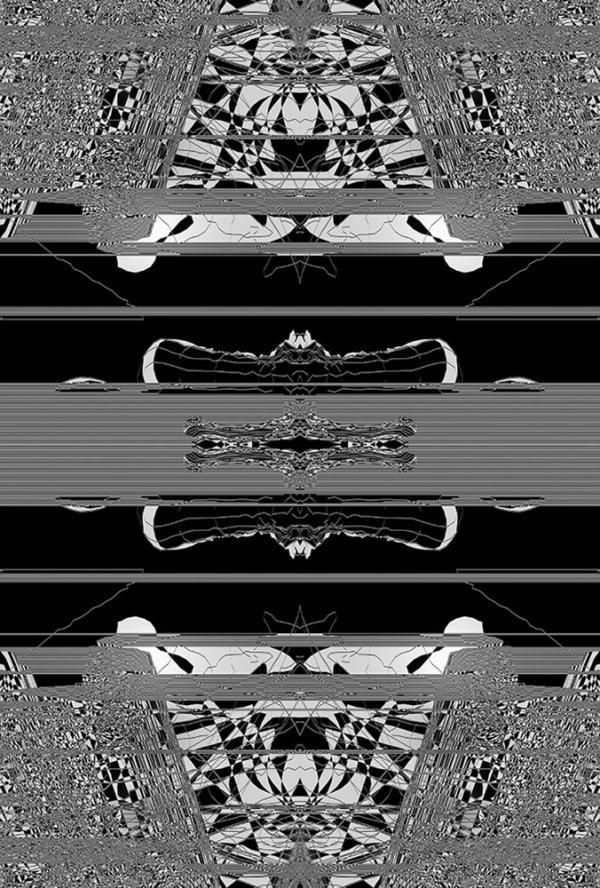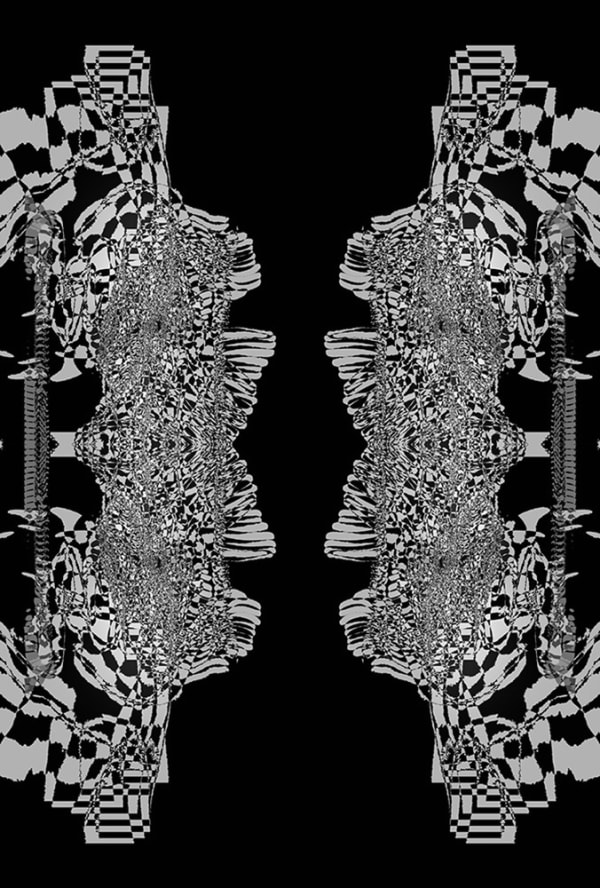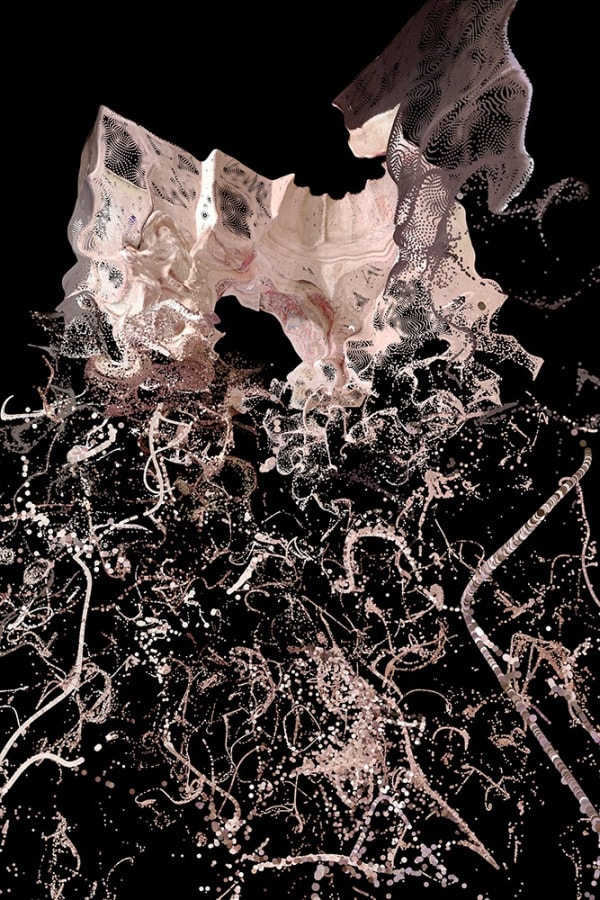-
ALI PHI | "LIMINAL"
Sep 19 - Oct 10, 2024 -
-
"Qal"
Interactive audiovisual installation -
"Qal"
Interactive audiovisual installationFor more information click Here.QAL, The anti-carpet, is an interactive generative audiovisual installation exploring environmental design in futuristic architecture with roots in old motifs.The initial idea of this project was to make a connection between ancient art concepts and link them with a new design objective in the form of installation or art piece. The key elements were Persian carpet which was the consequence of the idea of an earthly paradise spread through Persian literature from the time of the Achaemenid Dynasty. As the word expresses, such gardens would have been enclosed. The ideology's purpose was, to provide a place for protected relaxation in a variety of manners: spiritual, and leisurely.This Project was trying to make a new way of knitting carpets with help of technology and artificial intelligence to reach a new format and process of producing this context and let the creativity and interaction of humans merge into the process of creation of the artwork and have a direct effect on it. In contrast with traditional carpet, "QAL" is not a single pattern, it is so mortal which dies in less than a second and it is very easy to create by the motion of hands in real-time affected by light. The patterns form on a transparent vertical screen as a carpet loom with a light source in front which projects white light toward the hands of audiences and starts to generate patterns made by their movements, looking at their hands and remaking the motion in digital space through the computer visionary. After working with this AI-driven patch which is programmed and designed by the artist, some of the patterns were captured and were sent through the rendering process to reach a higher DPI & resolution being ready to be printed on different materials which the canvas was the first option.The results were new physical carpets with a lot of details in a very high dpi which were the outcome of human interaction and computer errors forming a pattern that can not be created easily through common software. Because of the countless possibilities of different parameters such as the amount of light in space, size & position of hands & color of skins, the patterns are unique and it is almost impossible to create the same one. -
-
The Enfe'al collection
-
The Enfe'al collection
For more information click here.The Enfe'al collection derives from the recent audiovisual set by Ali Phi entitled Maqruh. In Islamic terminology, the term makruh refers to a detestable act although it is neither forbidden nor entirely allowed. It exists within a space of liminal ambivalence – disapproved of but not punishable. The audiovisual set is inspired by this concept, as well as the contrasts between the dark ambiance and tranquillity of techno-electronic music paired with Middle-Eastern and West-Asian musical and visual motifs merged with western digital media processing technologies.The visual elements of the collection are created using 3D point clouds of ancient architecture, 2D videos processed through visual programming and creative coding, as well as digital 3D illustrations of reconstructed structures. Digital technologies allow the artist to examine ancient Persian architectures, their sacred geometries, histories and relationship to Islamic concepts like makruh, from a contemporary vantage point. The visual materials are modified by the soundscape and processed in real-time. The sound design includes field recordings of Iranian regional and ritual music. The beats are based on local patterns. Digital synthesizers produce the audio element.The main project is composed of seven elements. Together they depict the cyclical formation of an entity and include the following phases: passivity, avoidance, constriction, conformity, elevation, expiry and revival. The number seven holds significant meaning in West Asian culture, acting as a metaphor for infinity or completion. It is invoked frequently in prophetic narrations and sacred texts to illustrate the cosmic scale.These seven stages are based on the verb forms Enfeāl, which is used to assign the meaning of affectability to a verb and Efteāl, which is used to assign the meaning of obedience to a verb as well as the subject’s influence. These words are generally used in both Arabic and Farsi in the fields of science, mathematics, physics and chemistry (alchemy).
The Enfe'al exhibition explores select aspects of the Maqruh project, delving into the profound connections and reciprocal process of affecting and being affected. By employing technology-driven materials and navigating the interplay between ancient concepts, aesthetics, and modern digital presentation tools, Ali Phi explores the inherent uncertainty in decision making during the creative process.
The exhibition illustrates the fusion of traditional art and architectural aesthetics from the greater Iranian plateau with the latest advancements in real-time digital processing, offering a captivating exploration at the intersection between past and present, tradition and innovation and endless possibilities, probabilities, and contingencies. -
-
 Ali PhiEnfeal-3, 2024Print on metal
Ali PhiEnfeal-3, 2024Print on metal
Unique piece from collection of 25100 x 50 cm -
 Ali PhiEnfeal-9, 2024Print on metal
Ali PhiEnfeal-9, 2024Print on metal
Unique piece from collection of 2551 x 33 cm -
 Ali PhiEnfeal-6, 2024Print on metal
Ali PhiEnfeal-6, 2024Print on metal
Unique piece from collection of 2551 x 33 cm -
 Ali PhiEnfeal-4, 2024Print on metal
Ali PhiEnfeal-4, 2024Print on metal
Unique piece from collection of 2551 x 33 cm
-
-
Decompositions for Computers
-
DECOMPOSITIONS FOR COMPUTERS
For more information click Here.The digital realm, once heralded as an intangible utopia, is now intertwined and intrinsic, and demands introspection.As we navigate the expansive corridors of the internet, we must reckon with the repercussions of our digital existence. This artistic exploration by Ali Phi delves into the aesthetics of digital data, inspecting the digital waste that results from human activities in virtual landscapes.. Phi positions our impact as central to understanding/questioning the very nature of data storage, user influence, and the implicit trust we place in the virtual ecosystem.Embarking on a journey through the realms of techno-social activities, Ali Phi guides focus towards human impact. Decompositions for Computers, utilizes complex data sets to expose the unseen consequences of our digital footprints. By examining case studies of data waste in personal and corporate spheres, Ali Phi and his team have nurtured a responsive map of the evolving landscape of our digital detritus. This mapping creates a dynamic, generative audiovisual artwork—an immersive installation that breathes life into the overlooked remnants of our online activities. Digital waste, an environmental challenge stemming from poor data stewardship, is the focal point, with a spotlight on the carbon emissions and energy consumption inherent in the data-driven infrastructures of tech giants.
During the recording process, other sensory elements are recorded which activates those recalled memories and leads to the flow of thoughts that are sometimes considered Dejavus. The same logic is used in robotics and artificial intelligence navigation systems for wayfinding ignoring the recording process of feelings and other cognitive sensories.Digital waste is a new term that describes the environmental consequences of poor data stewardship. Digital waste is data waste, the long-term effects of storing vast amounts of information in a digital format whether that information is raw data, processed data, idle or in use. Often, experts use the term digital waste to refer to the carbon emissions and energy consumption produced by data-driven infrastructures like the massive database complexes that power cloud services offered by Microsoft, Google and Amazon. The rise of cloud storage and computing has made large-scale data storage cheaper and easier than ever. While it may seem like storing data shouldn’t be too energy-intensive, there is a carbon cost to data storage. For every 100 gigabytes of data you save and store in the cloud, you generate around 0.2 tons of carbon dioxide every year. This isn’t much CO2 compared to other carbon-generating activities, like driving a car or heating a home with gas. However, this carbon cost can add up quickly. In 2016, the average business saved and stored 347.56 terabytes of data, according to research from HubSpot. Keeping that amount of data stored would generate nearly 700 tons of carbon dioxide each year.The analysis begins by examining the percentage growth of internet users by country and year, integrating World Bank data, death rates, and world population information. With our uniquely trained system, calculations reveal a significant amount of data produced by the leftover traces of deceased individuals on the internet from 1990-2022 - data leftovers from dead populations expected to surpass that of the living. The next stage of our analysis focuses on the impact of emails on digital waste, projecting daily email numbers from 1990-2022. Carbon footprints caused by emails are quantified, reflecting pollution generated by both the living and the deceased on the internet grid. The analysis concludes with a projection of CO2 emissions by deceased individuals into 2050, highlighting the persistent growth of digital waste.The flow of the project happens in five different parts, starting with ”Formation, Creation, Connection”, the focus on the rising number of internet users in 226 different countries from 1990 based on the data acquired from The Word Bank. It continues with “Human Factor, Parallel Universe”, the energy consumption caused by growth of human users, handheld devices and web2 developments including early social media platform like Orkut, Hi5 and Yahoo 360 between years of 2000 to 2010. An AI trained model from the library of the users profiles on these platforms from cached pages were used to generate and manipulate the generative feed of portraits into the visuals of the scene.The study of the third decade of 2010-2020 is focused on nun-human vs human users including the energy consumption of good bots, bad bots and share of human factors based on the data acquired from Impreva, Statista and Cloudflare.2020 starts with all the effects of Covid-19 and rise of blockchain technology and NFTs, where the imaginative part of the project happened using AI to predict and extrapolate data for this decade and the next which will be the 4th and 5th part of the project. This scene continues, inspired by the phenomenon is recently known as the “Dead to Alive” ratio addressed on a research done by Oxford(5), as of September 2020, over 30 million people on Facebook are dead. It is expected that the number of dead people on social media will exceed actual living users by 2070. A data base of death and birth factors where injected into the internet users growth and a table of data consumed by deads were created for the last part that confronts with the same table for alive users to form the visual aesthetics of the last scene. -









